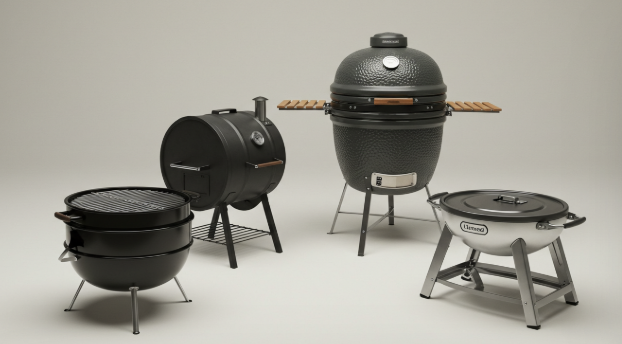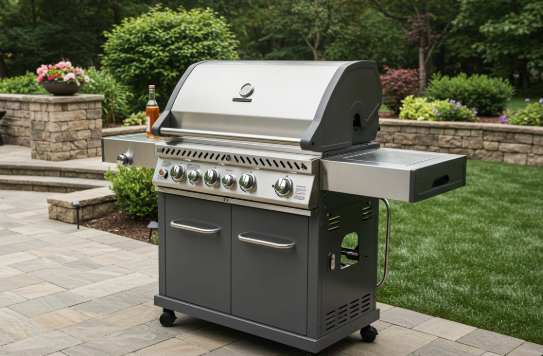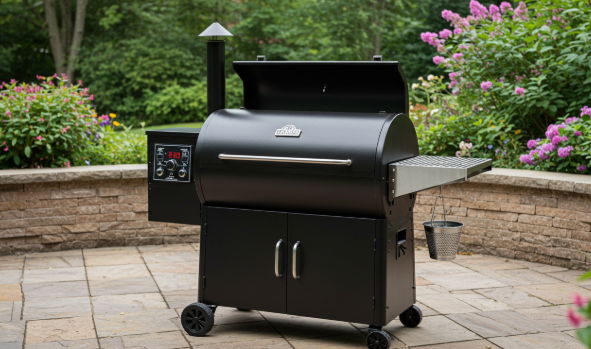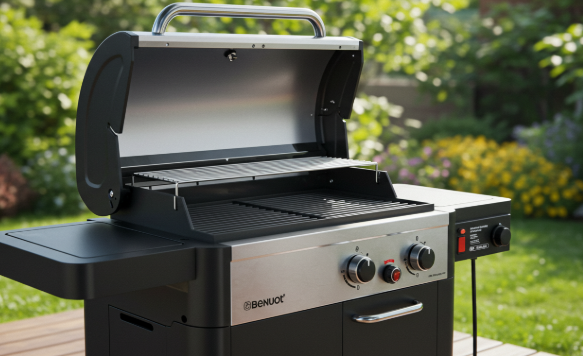Types of Charcoal Grills

- Kettle Grills: These are the most common and iconic type of charcoal grill. They feature a rounded shape with a lid, a bottom vent for airflow, and a simple design that makes them versatile and easy to use.
- Barrel Grills: Shaped like a large barrel, these grills offer a larger cooking surface and are ideal for cooking for larger groups. They can also double as smokers.
- Kamado Grills: Made from ceramic or other heat-retaining materials, kamado grills are highly efficient and versatile. They allow for high-temperature grilling, low-and-slow smoking, and even baking.
- Portable Charcoal Grills: Compact and lightweight, these are designed for on-the-go grilling, perfect for camping, tailgating, or picnics.
Key Features of Charcoal Grills
- Adjustable Air Vents: These control airflow, which directly impacts the temperature inside the grill. Opening the vents allows more oxygen in, increasing the heat, while closing them lowers the temperature.
- Charcoal Basket or Grate: Holds the charcoal and allows ash to fall through, promoting consistent airflow and heat distribution.
- Ash Catcher: Many models include a removable ash catcher for easy cleanup after grilling.
- Cooking Grates: Typically made of stainless steel or cast iron, these provide a durable surface for cooking and impart grill marks to food.
- Hinged or Removable Lid: A lid helps trap heat and smoke, allowing for versatile cooking methods such as direct grilling and indirect cooking.
Advantages of Charcoal Grills
- Flavor: Charcoal grills are known for creating a distinctive smoky flavor that many barbecue enthusiasts love.
- High Heat: They can reach much higher temperatures compared to gas grills, making them ideal for searing steaks and other meats.
- Versatility: With proper techniques, charcoal grills can handle a variety of cooking styles, from high-heat grilling to low-and-slow smoking.
- Affordability: Many charcoal grills are more affordable than their gas or electric counterparts, making them accessible to a wide range of users.
Disadvantages of Charcoal Grills
- Longer Startup Time: It takes time to light the charcoal and wait for it to reach the desired temperature.
- Temperature Control: Managing the heat requires practice and experience, as it is less precise compared to gas or electric grills.
- Cleanup: Dealing with ash and leftover charcoal can be messy and time-consuming.
- Fuel Cost Over Time: While the initial cost of the grill may be lower, the ongoing expense of purchasing charcoal can add up.
How to Use a Charcoal Grill
- Prepare the Charcoal: Arrange charcoal in a pile or use a chimney starter to light it. When using lighter fluid, allow it to burn off completely before adding food.
- Set Up the Grill: Spread the lit charcoal evenly for direct grilling or push it to one side for indirect cooking. Adjust the vents to control airflow.
- Preheat the Grill: Allow the grill to preheat for about 10-15 minutes. The coals should be covered in white ash before cooking.
- Cook the Food: Place food on the cooking grate and monitor the temperature. Use a meat thermometer for accuracy.
- Extinguish the Coals: When finished, close the vents and lid to extinguish the coals. Dispose of ash once the grill has cooled down.
Maintenance Tips
- Clean the cooking grate after each use to prevent food residue buildup.
- Empty the ash catcher regularly to maintain proper airflow.
- Store the grill in a dry, covered area to prevent rust and extend its lifespan.
Popular Charcoal Brands
- Weber: Known for their classic kettle grills, Weber is a trusted name in the industry.
- Big Green Egg: A premium brand specializing in kamado-style grills.
- Char-Griller: Offers a variety of affordable and durable charcoal grill options.
- PK Grills: Known for their robust and portable aluminum grills.
Conclusion
Charcoal grills offer an authentic grilling experience with unparalleled flavor. While they require a bit more effort and skill than other types of grills, many find the results to be well worth it. Whether you’re a beginner or a seasoned pitmaster, there’s a charcoal grill out there to suit your needs and preferences.
Gas grills are a popular choice for outdoor cooking enthusiasts due to their convenience, efficiency, and ease of use. These grills use propane or natural gas as a fuel source, allowing for quick heat-up times and precise temperature control. They are ideal for grilling a variety of foods, including burgers, steaks, vegetables, and more.
Types of Gas Grills

- Propane Grills: Portable and versatile, propane grills use refillable propane tanks and are perfect for outdoor spaces of all sizes.
- Natural Gas Grills: Ideal for permanent setups, these grills connect directly to your home’s natural gas line, offering an endless fuel supply.
Benefits of Gas Grills:
- Quick Start-Up: Gas grills ignite easily with a push-button or electronic ignition system, eliminating the need for lighter fluid or charcoal.
- Temperature Control: Adjustable knobs allow for precise heat management, making it easier to cook food evenly.
- Consistent Heat: Gas grills provide steady, even heat throughout the cooking process.
- Low Maintenance: Cleaning is typically easier compared to charcoal grills, as there are no ashes to dispose of.
- Versatility: Many gas grills come with additional features such as side burners, rotisserie attachments, and warming racks.
Features to Consider:
- Cooking Surface Area: Choose a grill that fits your cooking needs, whether you’re preparing meals for a small family or hosting larger gatherings.
- BTUs (British Thermal Units): A higher BTU rating indicates greater heating power.
- Material and Build Quality: Stainless steel grills are durable, rust-resistant, and easy to clean.
- Portability: Some grills are equipped with wheels for easy relocation, while others are designed to be stationary.
Tips for Using Gas Grills:
- Preheat the grill for about 10-15 minutes before cooking to ensure even heat distribution.
- Use a grill brush to clean the grates before and after each use.
- Keep the lid closed while cooking to maintain consistent temperatures and reduce cooking time.
- Always check for gas leaks and ensure proper ventilation when using the grill.
Gas grills are a convenient and reliable option for anyone who loves cooking outdoors. With a wide range of models and features available, there’s a gas grill to suit every lifestyle and cooking preference.
Types of Pellet Grills:

- Standard Pellet Grills: Designed for grilling, smoking, roasting, and baking. These are versatile and user-friendly.
- Portable Pellet Grills: Smaller, lightweight models ideal for camping, tailgating, or small spaces.
- Wi-Fi Enabled Pellet Grills: Equipped with smart technology to monitor and control temperature remotely via apps.
- Commercial Pellet Grills: Larger capacity grills suited for catering or professional use.
Benefits of Pellet Grills:
- Versatility: Combines grilling, smoking, roasting, baking, and even searing in one device.
- Ease of Use: Automated temperature control and consistent heat make it beginner-friendly.
- Flavorful Cooking: Wood pellets infuse food with rich, smoky flavors.
- Efficient Cooking: Maintains steady temperatures for even cooking with minimal supervision.
- Eco-Friendly: Uses renewable wood pellets, which produce less ash and are environmentally friendly.
- Wide Range of Temperature: Can operate at low temperatures for smoking or high heat for grilling.
- Low Maintenance: Minimal ash production makes cleanup relatively easy.
Tips for Using a Pellet Grill:
- Choose Quality Pellets: Use 100% hardwood pellets for optimal flavor and performance.
- Preheat Your Grill: Allow the grill to preheat for 10-15 minutes to achieve consistent cooking temperatures.
- Experiment with Pellets: Try different wood types like hickory, mesquite, or apple to enhance flavors.
- Use a Meat Thermometer: Always check the internal temperature of your food for precision cooking.
- Keep It Clean: Regularly clean the grill and empty the ash to maintain efficiency and longevity.
- Monitor Pellet Levels: Ensure the hopper stays adequately filled during long cooking sessions.
- Plan for Windy Weather: Shield your grill from wind to maintain stable temperatures.
- Don’t Over-Smoke: Avoid using too many pellets for smoking as it can overpower the flavor of your food.
- Practice Patience: Low and slow cooking often yields the best results for smoking meat.
- Cover When Not in Use: Use a grill cover to protect your pellet grill from weather and dust.
By understanding the types, benefits, and tips for using a pellet grill, you can elevate your outdoor cooking experience and enjoy delicious, smoky flavors in your meals.
Electric Grill

Outdoor electric grills are a fantastic solution for those who want the joy of grilling without the hassle of gas or charcoal. These grills are perfect for balconies, patios, or any space where traditional grilling methods may not be practical. Below, we’ve highlighted some key features to consider and some top models to explore.
Benefits of Outdoor Electric Grills
- Convenience: Simply plug it in, and you’re ready to start grilling.
- Compact Design: Ideal for small spaces, especially apartments or condos with restrictions on gas or charcoal grills.
- Ease of Use: No need to worry about propane refills or charcoal mess.
- Temperature Control: Many models feature precise temperature settings for consistent cooking.
Features to Look For
- Cooking Surface: Ensure the grill has enough space for your typical grilling needs.
- Nonstick Surface: Makes cleaning up much easier.
- Portability: Lightweight models with wheels or handles are great for moving around.
- Heat Distribution: Look for models with even heat distribution to avoid hot spots.
- Durability: Stainless steel or high-quality materials ensure long-lasting performance.
Top Outdoor Electric Grills
- Weber Q 2400 Electric Grill
- Large cooking area.
- Cast iron grates for even heat distribution.
- Sleek, durable design.
- George Foreman Indoor/Outdoor Electric Grill
- Versatile for indoor and outdoor use.
- Nonstick coating for easy cleanup.
- Large domed lid for grilling bigger cuts of meat.
- Char-Broil Patio Bistro Electric Grill
- Compact design perfect for patios.
- TRU-Infrared technology for even cooking.
- Easy-to-use temperature control knob.
- Cuisinart CEG-980 Outdoor Electric Grill
- Portable and lightweight.
- Foldable legs for easy storage.
- Heats up quickly and cooks evenly.
Tips for Using an Outdoor Electric Grill
- Preheat the grill for about 10–15 minutes to ensure even cooking.
- Use a meat thermometer to check the doneness of your food.
- Clean the grates after each use to maintain optimal performance.
- Avoid using metal utensils to protect the nonstick coating.
Conclusion
Outdoor electric grills offer an easy, efficient, and eco-friendly way to enjoy the flavors of grilled food. Whether you’re cooking for a family barbecue or a small gathering of friends, there’s an electric grill to fit your needs. Explore the options, and start grilling with ease!
